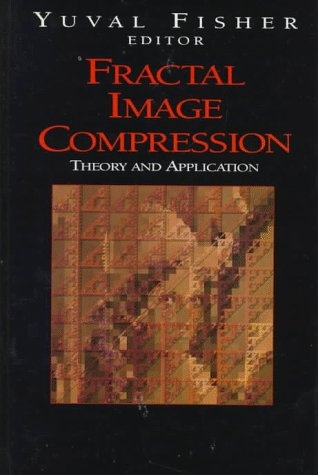
Fractal Image Compression
Springer-Verlag New York Inc.
978-0-387-94211-7 (ISBN)
- Titel erscheint in neuer Auflage
- Artikel merken
1 Introduction.- 1.1 What Is Fractal Image Compression?.- 1.2 Self-Similarity in Images.- 1.3 A Special Copying Machine.- 1.4 Encoding Images.- 1.5 Ways to Partition Images.- 1.6 Implementation.- 1.7 Conclusion.- 2 Mathematical Background.- 2.1 Fractals.- 2.2 Iterated Function Systems.- 2.3 Recurrent Iterated Function Systems.- 2.4 Image Models.- 2.5 Affine Transformations.- 2.6 Partitioned Iterated Function Systems.- 2.7 Encoding Images.- 2.8 Other Models.- 3 Fractal Image Compression with Quadtrees.- 3.1 Encoding.- 3.2 Decoding.- 3.3 Sample Results.- 3.4 Remarks.- 3.5 Conclusion.- 4 Archetype Classification in an Iterated Transformation Image Compression Algorithm.- 4.1 Archetype Classification.- 4.2 Results.- 4.3 Discussion.- 5 Hierarchical Interpretation of Fractal Image Coding and Its Applications.- 5.1 Formulation of PIFS Coding/Decoding.- 5.2 Hierarchical Interpretation.- 5.3 Matrix Description of the PIFS Transformation.- 5.4 Fast Decoding.- 5.5 Super-resolution.- 5.6 Different Sampling Methods.- 5.7 Conclusions.- A Proof of Theorem 5.1 (Zoom).- B Proof of Theorem 5.2 (PIFS Embedded Function).- C Proof of Theorem 5.3 (Fractal Dimension of the PIFS Embedded Function).- 6 Fractal Encoding with HV Partitions.- 6.1 The Encoding Method.- 6.2 Efficient Storage.- 6.3 Decoding.- 6.4 Results.- 6.5 More Discussion.- 6.6 Other Work.- 7 A Discrete Framework for Fractal Signal Modeling.- 7.1 Sampled Signals, Pieces, and Piecewise Self-transformability.- 7.2 Self-transformable Objects and Fractal Coding.- 7.3 Eventual Contractivity and Collage Theorems.- 7.4 Affine Transforms.- 7.5 Computation of Contractivity Factors.- 7.6 A Least-squares Method.- 7.7 Conclusion.- A Derivation of Equation (7.9).- 8 A Class of Fractal Image Coders with Fast Decoder Convergence.- 8.1 Affine Mappings on Finite-Dimensional Signals.- 8.2 Conditions for Decoder Convergence.- 8.3 Improving Decoder Convergence.- 8.4 Collage Optimization Revisited.- 8.5 A Generalized Sufficient Condition for Fast Decoding.- 8.6 An Image Example.- 8.7 Conclusion.- 9 Fast Attractor Image Encoding by Adaptive Codebook Clustering.- 9.1 Notation and Problem Statement.- 9.2 Complexity Reduction in the Encoding Step.- 9.3 How to Choose a Block.- 9.4 Initialization.- 9.5 Two Methods for Computing Cluster Centers.- 9.6 Selecting the Number of Clusters.- 9.7 Experimental Results.- 9.8 Possible Improvements.- 9.9 Conclusion.- 10 Orthogonal Basis IFS.- 10.1 Orthonormal Basis Approach.- 10.2 Quantization.- 10.3 Construction of Coders.- 10.4 Comparison of Results.- 10.5 Conclusion.- 11 A Convergence Model.- 11.1 The r Operator.- 11.2 Lp Convergence of the RIFS Model.- 11.3 Almost Everywhere Convergence.- 11.4 Decoding by Matrix Inversion.- 12 Least-Squares Block Coding by Fractal Functions.- 12.1 Fractal Functions.- 12.2 Least-Squares Approximation.- 12.3 Construction of Fractal Approximation.- 12.4 Conclusion.- 13 Inference Algorithms for WFA and Image Compression.- 13.1 Images and Weighted Finite Automata.- 13.2 The Inference Algorithm for WFA.- 13.3 A Fast Decoding Algorithm for WFA.- 13.4 A Recursive Inference Algorithm for WFA.- A Sample Code.- A.l The Enc Manual Page.- A.2 The Dec Manual Page.- A.3 Enc.c.- A.4 Dec.c.- A.5 The Encoding Program.- A.6 The Decoding Program.- A.7 Possible Modifications.- B Exercises.- C Projects.- C.1 Decoding by Matrix Inversion.- C.2 Linear Combinations of Domains.- C.3 Postprocessing: Overlapping, Weighted Ranges, and Tilt.- C.4 Encoding Optimization.- C.5 Theoretical Modeling for Continuous Images.- C.6 Scan-line Fractal Encoding.- C.7 Video Encoding.- C.8 Single Encoding of Several Frames.- C.9 Edge-based Partitioning.- C.10 Classification Schemes.- C.l1 From Classification to Multi-dimensional Keys.- C.12 Polygonal Partitioning305.- C.13 Decoding by Pixel Chasing.- C.14 Second Iterate Collaging.- C.15 Rectangular IFS Partitioning.- C.16 Hexagonal Partitioning.- C.17 Parallel Processing.- C.18 Non-contractive IFSs.- D Comparison of Results.- E Original Images.
| Zusatzinfo | 23 black & white tables, biography |
|---|---|
| Verlagsort | New York, NY |
| Sprache | englisch |
| Gewicht | 661 g |
| Einbandart | gebunden |
| Themenwelt | Informatik ► Grafik / Design ► Digitale Bildverarbeitung |
| Mathematik / Informatik ► Mathematik ► Allgemeines / Lexika | |
| ISBN-10 | 0-387-94211-4 / 0387942114 |
| ISBN-13 | 978-0-387-94211-7 / 9780387942117 |
| Zustand | Neuware |
| Haben Sie eine Frage zum Produkt? |
aus dem Bereich



